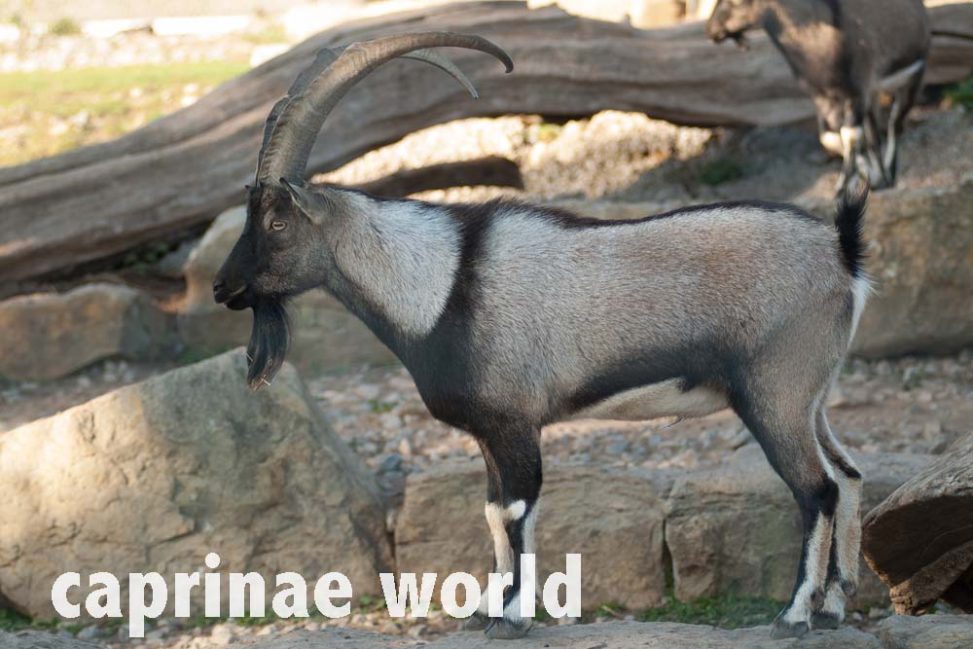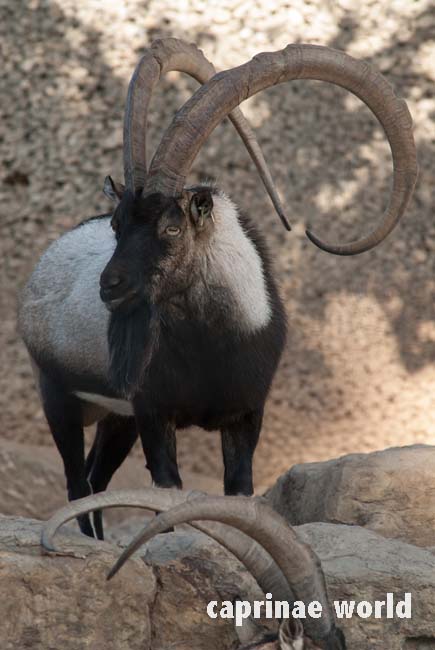It is the smallest of all „wild“ goats [7] and the national emblem of the Mediterranean island of Crete with immense cultural significance. [2]
Names
Cretan: Agrimi („the wild one“) [61]; males are called „agrimi“, females „sanada“ [2]
English: Kri-kri, Cretan goat, Agrimi, Cretan Ibex [Wikipedia], Kri-Kri Ibex [2]; Cretan Feral Goat [1]
French: chèvre sauvage crétoise [2, Wikipedia], Agrimi, Kri-Kri [Wikipedia]
German: Kretische Wildziege, Agrimi [5, Wikipedia], Kri-kri [Wikipedia], Kreta-Wildziege [2]
Russian: Кри-кри́, также критский горный козёл, агри́ми [Wikipedia]
Spanish: kri-kri [Wikipedia], Capra de Creta, Bezoar de Creta [2]
Turkish: yaban keçisi, kayeek [61]
Taxonomy
Capra hircus cretica, Schinz 1838
Diploid chromosome number: 2n=60 [2]
Other putative scientific names [2]
Capra aegagrus cretensis, Lorenz 1809
Capra cretica, Schinz 1838
Capra hircus picta, Erhard 1858
Aegocerus pictus, Erhard, 1858
Capra aegagrus, Sclater 1886
Capra aegagrus var. jourensis, Ivrea 1899
Capra hircus cretensis, Lydekker 1901
Distribution
by country: Greece
by islands: Crete with Theodorou [61] (Agii Theodori [7]), Dhia, Aghii Pantes [61] (Agii Apostoli) [2]; Sapientza; Erimomilos (Antimilos / Andimilos) – (or extinct? – see below), Psili, Moni, Atalandi, Youra [61] (Gioura [2]), Samothrake [2] (or extinct? – see below)
The population on the main island of Crete is restricted to an area of about 72 km² in the Lefka Ori (White Mountains) in the western part of the island, including Samaria Gorge / Samaria National Park. [2]
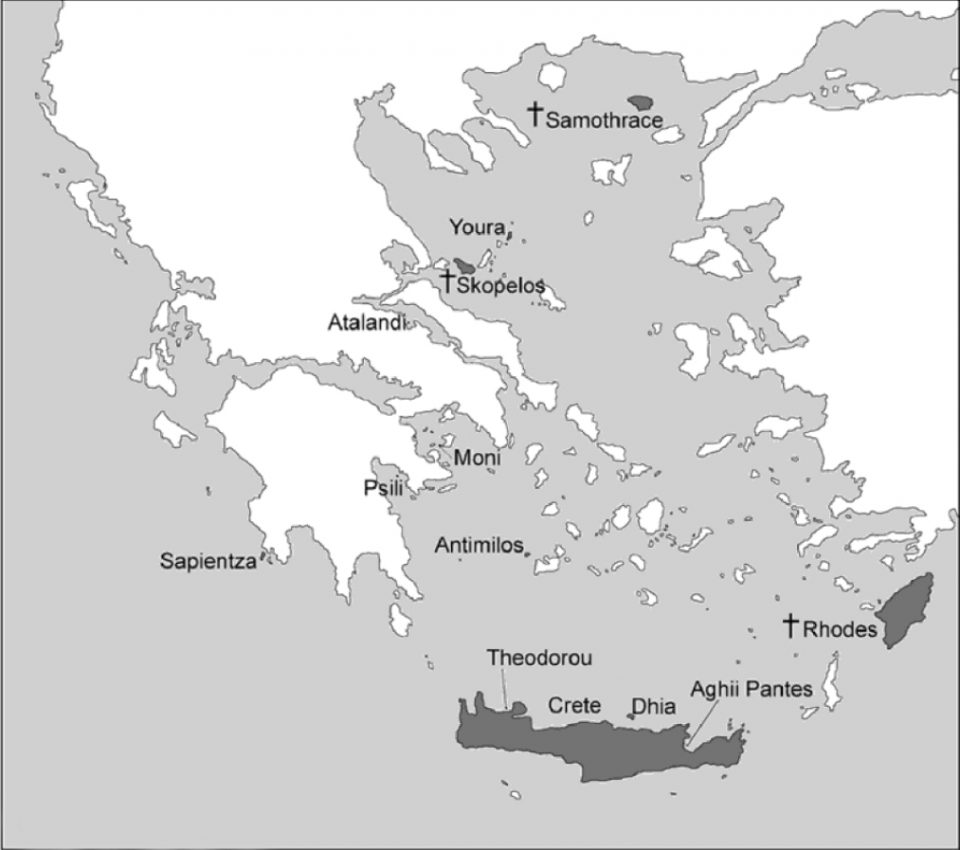
Source: Masseti, Marco, 2012: Atlas of terrestrial mammals of the Ionian and Aegean islands [61] – altered
locations on mainland: Mt. Parnitha, near Athens (originating from Lefka Ori); Czech Republic (Pedrotti and Lovari 1999) and Macedonia [2]
Apparently there are a number of other small populations in private areas and state controlled hunting reserves (Papaioannou 2010) [2]
extinct on: Rhodes, Skopelos, Samothrace [61], Erimomilos near Milos [7], Cyprus, Karpathos, Dragonada, off the easternmost coast of Crete [61]
Origin: Molecular analyses and genetic and archaeo-zoological studies (Hiendleder et al. 1998; Manceau 1999; Bar-Gal 2002) suggest that the Agrimi is not, as previously thought, a distinct Wild Goat subspecies but rather a feral descendant of the prehistoric Capra stocks which arrived on Crete in the Aceramic Neolithic (about 7.000 BC) [2] or even 9.000 BC (see below) [61]. Matschei (2012) describes the Agrimi as a „primitive feral goat“. [7] Some of these semi-domesticated goats escaped, giving rise to feral populations, the descendants of which have survived up to the present. Back in the wild, they maintained similar morphological patterns to their near-eastern ancestors, the Bezoar (C. aegagrus). There is another hypothesis (Horwith and Bar Gal et al. 2002) which suggests that the Cretan Wild Goat may be wild in origin, even though introduced by humans to Crete, but has subsequently partially interbred with domestic animals (seen in Papaioannou 2010). These ancient feral forms are of interest as „living fossils“ and repositories of important genetic diversity (Shackleton 1997), representing the very earliest domestic stock little changed from its primitive state, and deserve protection [2]. In that sense Groves and Grubb (2011) consider the Cretan Wild Goat as „extremely valuable“. [4]
Wild goats were brought to the islands since ancient times. They were released so that they could breed and provide a store of fresh meat that would be readily available along the maritime routes of antiquity. Mostly small and barren islets were chosen for that purpose, which could not be cultivated and were otherwise unattractive in human economic terms [61].
The oldest literary reference for the occurrence of wild goats on Mediterranean islands is found in Homer’s Odysseus. Homer describes an isle of wild goats, where Odysseus and his companions land to hunt before the Cyclops episode (The Odyssey, book 9, 133-et seqq.). [61]:
| Opposed to the Cyclopean coasts, there lay An isle, whose hills their subject fields survey; Its name Lachaea, crown’d with many a grove, 135 Where savage goats through pathless thickets rove: No needy mortals here, with hunger bold, Or wretched hunters through the wintry cold Pursue their flight; but leave them safe to bound From hill to hill, o’er all the desert ground. 140 Nor knows the soil to feed the fleecy care, Or feels the labours of the crooked share; But uninhabited, untill’d, unsown It lies, and breeds the bleating goat alone. … Till safe we anchor’d in the shelter’d bay: Our sails we gather’d, cast our cables o’er, And slept secure along the sandy shore. Soon as again the rosy morning shone, Reveal’d the landscape and the scene unknown, 175 With wonder seized, we view the pleasing ground, And walk delighted, and expatiate round. Roused by the woodland nymphs at early dawn, The mountain goats came bounding o’er the lawn: In haste our fellows to the ships repair, 180 For arms and weapons of the sylvan war; Straight in three squadrons all our crew we part, And bend the bow, or wing the missile dart: The bounteous gods afford a copious prey, And nine fat goats each vessel bears away: 185 The royal bark had ten. Our ships complete We thus supplied: (for twelve were all the fleet.) Here, till the setting sun rolled down the light, We sat indulging in the genial rite; Nor wines were wanting; those from ample jars We drain’d, the prize of our Ciconian wars. 191 The land of Cyclops lay in prospect near; The voice of goats bleating flocks we hear, … | |||
„Facts“ referring to The Odyssee: Cyclopes have been associated with the island of Sicily and the volcanic Aeolian Islands. Lachea (or Isola di Aci) is the biggest of the Islands of the Cyclopes, about 100 metres off the harbour of the Sicilian settlement Aci Trezza. But the surface measures only two hectares [Wikipedia]. However in the German Odyssey translation by Roland Hampe „Lachea“ is not mentioned at all. Concerning the abundance of goats on Lachea – or whatever island it actually was: Ulysses‘ men hunted 109 goats in one morning. – Homerian criticism dates the definitive version of The Odyssey to the 7th century BC. [61]
However according archaeological evidence the first occurrence of wild goats on Mediterranean islands is even more ancient. Wild goats made their first appearance on the Mediterranean islands sometime after the end of the 9th millennium BC. The first evidence for their introduction comes from Cyprus, where the earliest osteological remains of the species were provided by the archaeological exploration of the prehistoric site of Shillourokampos, in the south-western part of the island, referred to as the Pre-Pottery Neolithic period. Archaeological evidence of the introduction of Capra aegagrus on the Aegean islands, such as Crete and Youra (Northern Sporades), also exists, dating respectively to the Pre-Pottery Neolithic and the Mesolithic periods. [61]
In the course of the 20th century, the Cretan Wild Goat was introduced onto the islands of Theodorou (1928-1946); Aghii Pantes (1951); Dhia (1957); Sapientza, Ionian island (1983); Moni, Saronic Gulf (1961 and 1983); off the south-western coast of the Peloponnese; Atalandi (1984-1985), in the Gulf of Euboea. [61]
The occurrence of wild goats in very recent historical times has also been reported on the island of Skopelos, in the Northern Sporades and on Euboea. An old record (May 1942) for the occurence of Capra aegagrus hircus on the small islets of Dragonada (3,5 km²), off the easternmost coast of Crete, is available in the collection of the Naturhistorisches Museum of Vienna. Wild goats of aegagrus phenotypes were also reputed to occur in the mountainous areas of Rhodes, in very recent historical times.
Rhodes: In 1888, for example, M. P. Matschie presented to the Zoologial Museum of Berlin a specimen from this island, in which the horns were more developed than those of the Cretan Wild Goat, but less than those of the nominal form, the Asia Minor Pasang. As far back as 1943-1944, Tortonese reported that on Rhodes there was a custom of keeping specimens of wild goat, imported from Anatolia, in conditions of captivity in private enclosures. [61]
Putative subspecies
Populations of wild goat reported from the islands of the Aegean Sea have been described as belonging to three different types [61]:
- Cretan Agrimi or Cretan Wild Goat (formerly described as Capra aegagrus cretica, Schinz 1838). This is the phenotype described for Crete, where it is reported to have occupied most of the mountainous regions as recently as 1850, and/or the beginning of the last century. However, as a result of habitat loss and hunting, only relic populations remain in the rugged areas of the White Mountains (Lefka Ori), in Western Crete.
- Aegean Agrimi or Aegean Wild Goat (formerly described as Capra aegagrus pictus, Erhard 1858). This phenotype is still present on the islet of Antimilos, or Erimomilos („desert milos“), off the north-western coast of Milos, but it appears to have become extinct on Samothrace before the end of the 1980s. Erhard was the first to distinguish this population as a different taxon, or at least as a distinctly characterised variety.
- Youra Wild Goat (formerly described as Capra aegagrus dorca, Reichenow 1888). It inhabits the islet of Youra, in the Northern Sporades. Lorenz-Liburnau called it Capra hircus dorcas.
Pure or not pure? Masseti (2012) states that from a morphological point of view, all these insular populations are closely connected with the true Wild Goat, the Asiatic Bezoar Goat [61]. Shackleton (1997) and Papaioannou (2010) report that animals from the islands of Dia, Agii Pantes (Agii Apostoli), Erimomilos (Antimilos), Samothrake, Gioura (Youra) and others, as well as populations in the Czech Republic (Pedrotti and Lovari 1999) and Macedonia are considered hybrids of „wild“ and modern domestic or feral goats. [2] Matschei (2014) – quoting Grzimek (1988) – states that only animals from 68 ha islet Agii Theodori are pure-blooded. [7]
Description
general appearance: The Agrimi still displays more or less the same phenotypical patterns as the Bezoar Goat (Capra aegagrus aegagrus) [61]. Body size is somewhat smaller than in the Bezoar Wild Goat. Feral-goat hybrids from the Northern Sporades and the Cyclades are considerably smaller still [2]. It is actually the smallest of all „wild“ goats [7].
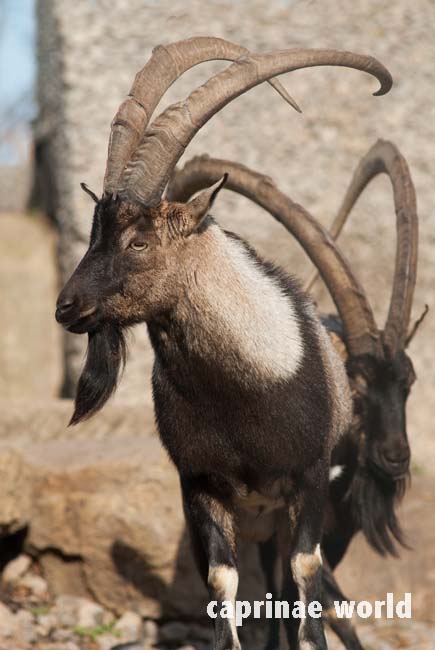
head-body: 90 [1] – 120 cm [7]
shoulder height: males 60 [1] – 70 cm [7]; females 45 cm [1]
weight: 26-42 kg [1]; males 40 kg, females 20 kg [7]
weight at birth: 2,05-2,2 kg [7]
Colouration / pelage
similar to the Bezoar Wild Goat; with tawny-greyish or sandy being predominant as base colouration interspersed with greyish-white hairs. [2]
summer coat: reddish-brown with blackish-brown markings [1]
winter coat: reddish-brown parts turn ashy grey in adult males [1]
females: brownish tan at all seasons. [1]
blackish-brown markings: on shoulders, face and legs; as a separation line between sandy upper body and creamy-white underparts; dorsal line extending from the base of the cranium to the base of the tail [2]
face: predominantly blackish with some elongated sand-coloured markings extending from above the eyes to the cheeks and muzzle. [2] Probably predominantly seen in females
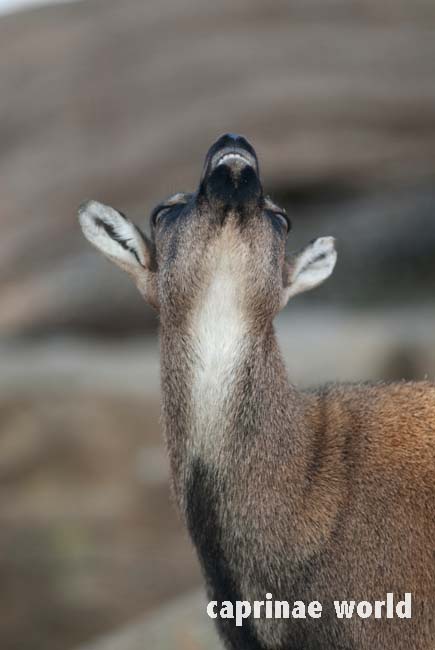
ears: upright with the inside being black, fringed by light-coloured hair
beard: typical black; present in males [2]
tassels or wattles: the cartilaginous outgrowths emerging at the base of the throat in many domestic goats, are absent [2]
legs: fronts with black stripe, creamy coloured towards the back [2] – black stripes seen on hind legs too; calluses on knees [1]
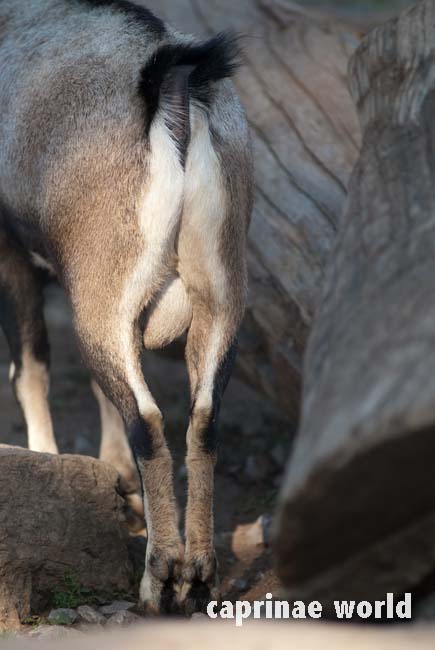
Horns
characterised by scimitar-shaped [2], laterally compressed [1], sharply keeled horns present in both sexes, considerably longer in males. The horns emerge close together on the forehead [2]. Tips are often convergent.
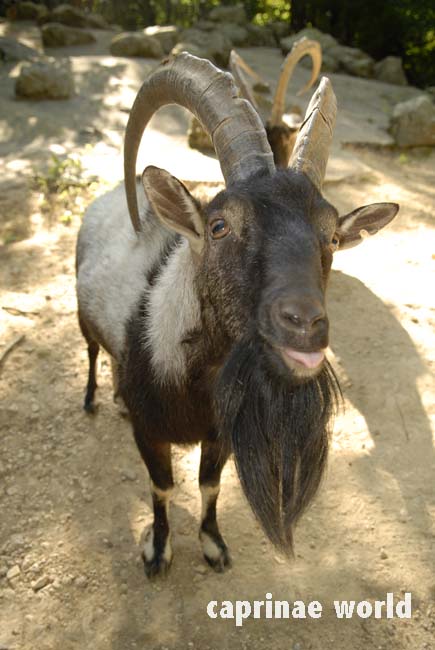
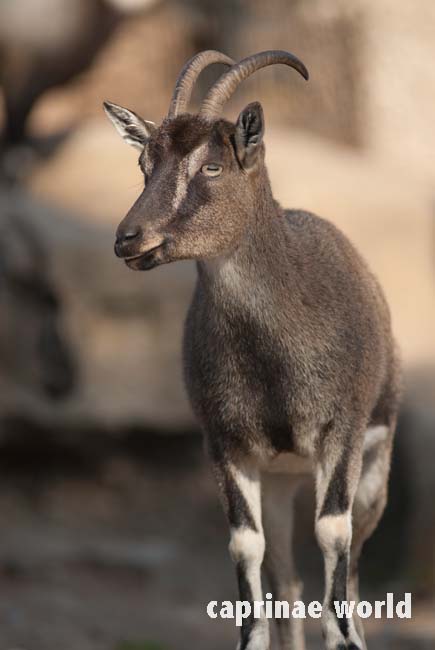
horn length: males – to 90 cm, females to 33 cm [1]
Two specimens are registered in Rowland Ward:
longest horns: 100 cm [2]
mean horn length: 78,4 cm [2]
base circumference: 15,6 cm and 20,3 cm [2]
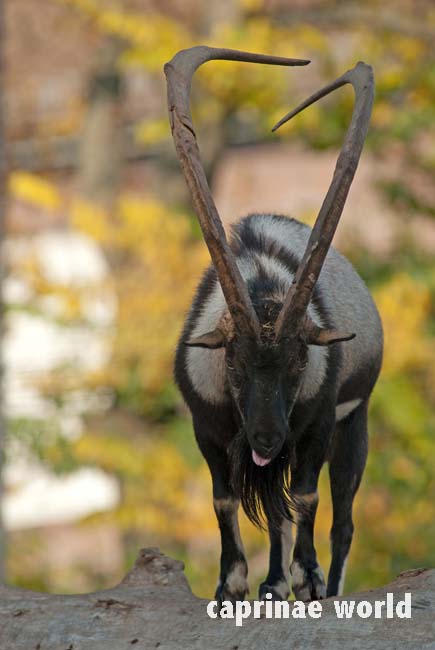
feral-goat hybrids occurring in the Cyclades and elsewhere have considerably shorter horns. Those from the Northern Sporades turn outward with a slight twist into an open spiral shape. [2]
Similar taxa
The Cretan Wild Goat (Capra hircus cretica) is smaller and more distinctly coloured than the typical Wild Goat (Capra aegagrus). [1]
Compared to Agrimi, the domestic-x-Wild-Goat-hybrids‘ coat appears to be slightly longer and interspersed with black hairs. The horns are curved outwards a little more and are more robust. The resting tail is held more horizontal than downwards. [2]
Habitat
Cretan Wild Goat live in relatively arid mountain areas where there is a mixture of rocky outcrops or scree slopes and vegetation (shrubby maquis thickets or conifer forests) [2]. The density on Agii Theodori, off Crete, is 143 animals per km² – compared to 1 to 4 Wild Goats in Pakistan. [7]
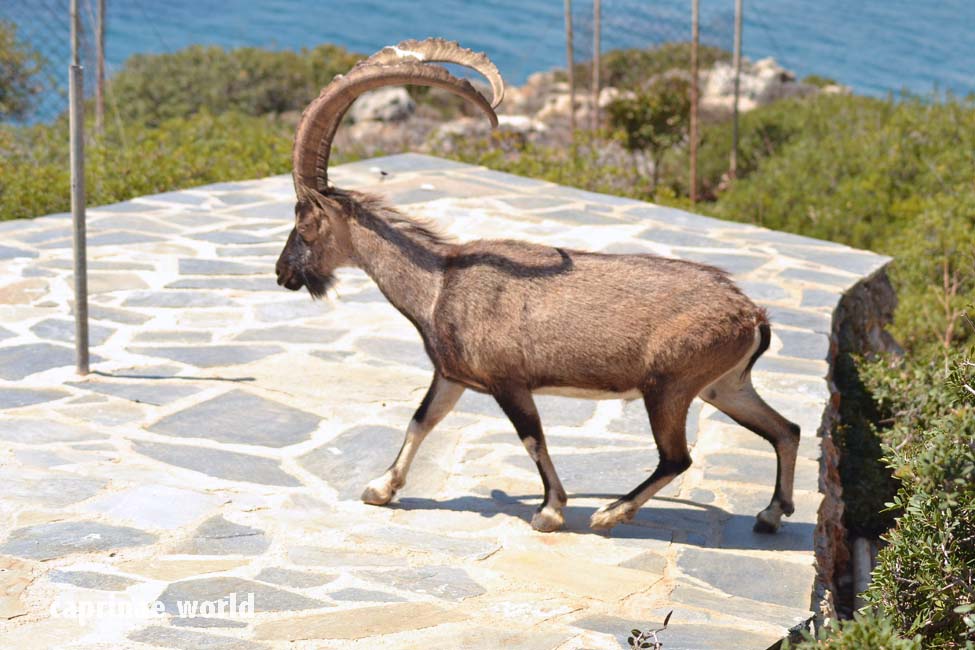
Food and feeding
grasses, herbaceous plants and shrubs [2]
Predators / Mortality
Fox (Vulpes vulpes) and Golden Eagle (Aquila chrysaetos) is imaginable (not confirmed)
Breeding
mating season: on Crete from mid October into November (Husband 1977) [7]
time of birth: at Tierpark Berlin during day, early mornings [7]
afterbirths: not eaten by mothers [7]
Acitivity pattern
High ambient temperatures influence the daily and seasonal activity patterns. Usually the animals are seen in patches of open ground only during the cooler hours of the morning and evening. The animals are usually seeking shelter from the day’s excessive heat in dense Mediterranean brush. Agrimi are often solitary but occur also in small groups of varying composition. [2]
Status
The total number of „pure origin“ Agrimi in wild populations (Mt. Lefka Ori and Samaria National Park, Theodorou Island and possibly Mt. Parnitha) is a least 600 to 700 animals (Papaioannou 2010). [2]
Threats
The main problem affecting the conservation of Cretan Wild Goats is hybridisation with domestic goats, which is thought to occur even within the unique and long-established wild populations on Mt. Lefka Ori (Adamakopoulos 1997, seen in Papaioannou 2010) and Samaria National Park. A further complication is inbreeding which inevitably occurs in small introduced populations which all originates from three Lefka Ori pairs introduced to Theodorou Island in 1928, 1937 and 1945 (Papaioannou 2010). Poaching, food competition with livestock, and human infrastructure like increased road accessibility and disturbance through tourism are additional problems. [2]
Conservation
Agrimi are strictly protected in Crete and the adjacent islets like Theodorou Island (Greek National Law of 1969, presidential decree 86/89, and following modifications). Apparently there are no current management plans in operation in the protected areas of Crete other than an attempt to control poaching. [2]
Shackleton (1997) suggested that it may be desirable to eradicate domestic-x-wild-goat-hybrids. He cautioned, however, that F1 hybrids would be difficult to distinguish from pure Agrimi in either external appearance or behaviour. Shackleton proposed that it may be desirable to determine the degree of hybridisation of the goats found on the various islands to help direct conservation management decisions. [2]
Hunting
Very low quotas of Cretan Wild Goat are available for hunting in State controlled hunting reserves and state and private game enclosure (Papaioannou 2010). On Sapienza and Atalanti, the Cretan Wild Goat populations are managed by the Greek authorities overseeing wildlife and national parks for sustainable use through recreational hunting (Hellenic Forestry Service, attached to the Ministry of Rural Development and Food). The rules governing access and hunting on the islands are very strict. [2]
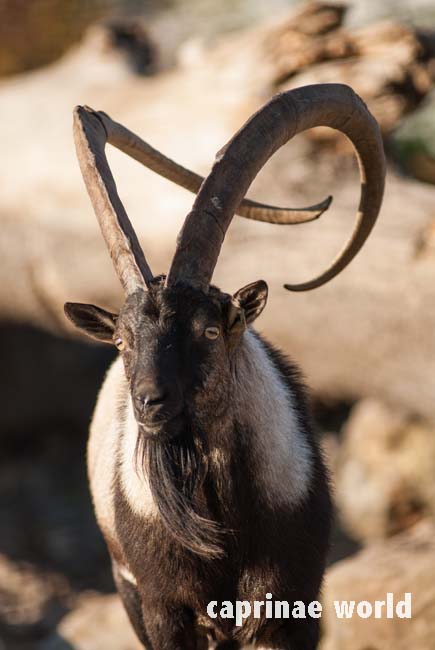
Atalanti allows hunting from September through February, but only on Fridays when the island is closed off to sightseeing. Hunters are not allowed to overnight and are ferried between the island and mainland by boat (Crown, The Hunting Report 2009). [2]
The hunting season on Sapienza is limited to the month of November and, although hunting is allowed five days a week, effective hunting days are restricted to three per week. [2]
Agrimi hunting permits are given each season to a maximum of six to eight foreign hunters and 20 resident hunters (Crown, The Hunting Report 2009). [2]
Ecotourism
Heavily frequented Samaria Gorge on Crete is probably THE PLACE to look for Agrimi. For Theodorou Island you need a permit to get there (Eric Dragesco, pers. comm.) Mt. Parnitha / Mt. Parnitha National Park, north of Athens, seems like an easily accessible place. However while Red Deer is a well documented species by tourists on Mt. Parnitha, a hint of the existence of Agrimi could only be found on the website of the National Park – www.parnitha-np.gr
Literature cited
[1] Castelló, José R., 2016: Bovids of the World – Antelopes, Gazelles, Cattle, Goats, Sheep, and Relatives. Princeton University Press
[2] Damm, Gerhard R. and Franco, Nicolás, 2014: The CIC Caprinae Atlas of the World – CIC International Council for Game and Wildlife Conservation, Budakeszi, Hungary in cooperation with Rowland Ward Publications RSA (Pty) Ltd., Johannesburg, South Africa
[4] Groves, Colin and Grubb, Peter, 2011: Ungulate Taxonomy. The John Hopkins University Press
[5] Grzimek, Bernhard (Hrsg.), 1988: Grzimeks Enzyklopädie, Säugetiere, Band 5. Kindler Verlag, München
[6] Homer: The Odyssey, 1837. Book 5-24, Translated by Alexander Pope, ESQ., New York: Harper&Brothers.
[61] Masseti, Marco, 2012: Atlas of terrestrial mammals of the Ionian and Aegean islands. De Gruyter, Berlin / Bosten
[7] Matschei, Christian, 2012: Böcke, Takine & Moschusochsen. Filander Verlag
[10] Schaller, George B., 1977: Mountain Monarchs – wild sheep and goats of the Himalaya. The University of Chicago Press
[16] Wilson, D. E. and Mittermeier, R. A. [eds], 2011: Handbook of the mammals of the world. Vol. 2. Hoofed mammals. Lynx Edicions, Barcelona.

